Physical Address
304 North Cardinal St.
Dorchester Center, MA 02124
The diagnosis of acute rhinosinusitis is made on clinical grounds, and imaging is reserved for cases with suspected intracranial and orbital complications.
Computed tomography (CT) is the modality of choice in imaging of chronic rhinosinusitis (CRS) and planning for functional endoscopic sinus surgery (FESS) because of the excellent bone detail provided.
Acute secretions of the sinuses are of low attenuation on CT and resemble fluid signal on magnetic resonance imaging (MRI). With increasing dehydration of the secretions, the protein concentration increases, resulting in increased attenuation on CT exams and decreased T2 signal on MRI. The T1 signal initially increases, then decreases with increasing concentration of proteinaceous content.
Anatomic variants are very common and should not be perceived as the cause of CRS, although these may be responsible for lack of response to treatment and recurrence.
The earliest imaging signs of acute invasive fungal rhinosinusitis are edema and swelling in the perisinus soft tissues and focal bone destruction of the sinus wall, which at times can be subtle on imaging.
Allergic fungal rhinosinusitis shows characteristic high density on CT and decreased signal on T2 and low to intermediate signal on T1-weighted MRI.
The most common site of intracranial penetration or cerebrospinal fluid (CSF) leak associated with FESS is the anterior and medial cribriform plate, which is formed by the lateral lamella of the cribriform niche, the extent and thickness of which are subject to individual variation that needs to be carefully evaluated before any surgery.
The optic nerves and internal carotid arteries may be vulnerable to injury during FESS because of variations in their anatomic relation to pneumatized cells and the dehiscences of bony coverings.
Squamous cell carcinoma (SCC) is the most common malignancy in the sinonasal cavity. Numerous other neoplasms occur that include nonsurgically treated entities such as lymphoma and rhabdomyosarcoma, which make tissue diagnosis a necessity before treatment.
Nonmalignant etiologies can mimic neoplasms and should be approached with care to avoid potentially unnecessary and dangerous surgeries.
Plain radiographs for the evaluation of the paranasal sinuses have largely been replaced by computed tomography (CT), mainly because of tissue overlap problems, poor visualization of the posterior ethmoids and ostiomeatal complexes, and inherent deficiencies in depicting soft tissues relative to CT. Plain radiographs are of little use in modern practice for evaluation of sinonasal disease process.
CT is the current imaging standard for the evaluation of rhinosinusitis because of its exquisite ability to display and differentiate between hypertrophic mucosa, bone, and air. It also complements magnetic resonance imaging (MRI) for evaluation of tumors in many cases. CT data also serve to guide surgical navigation and planning. Multichannel (multislice) CT scanners are readily available in most imaging centers and provide a quick and comprehensive evaluation of the head and neck anatomy. There is no requirement for patients to hold their breath for relatively long periods of time while lying prone on the CT table with their head extended to obtain direct coronal slices. The advent of slip-ring technology and subsequent multichannel scanners allows for very thin slices to be acquired in the transverse plane, which are almost instantaneously reconstructed in any desired plane in two- or three-dimensional formats.
However, CT utilizes ionizing radiation, which has a stochastic effect on the development of malignancies, and these may come to medical attention many years after the inciting radiation exposure. This is a significant concern for patients who receive numerous repeated scans, especially for children. Various dose-lowering strategies are used by different manufacturers and radiologists, although the referring physicians should also bear responsibility and help eliminate unnecessary CT examinations. Flat panel–based cone-beam computed tomography (CBCT) is a recently developed technology that potentially decreases radiation dose by 50% to 70% compared with multichannel (multislice) CT. CBCT allows for relatively good resolution of bony structures in the maxillofacial area; however, it has poor soft tissue contrast and should not be relied upon for assessment of soft tissues. Iodinated contrast administration is not needed for evaluation of rhinosinusitis and should be reserved to assess neoplastic diseases and complications of acute sinusitis in select cases.
MRI at a magnetic field strength of 1.5 T or greater is the preferred modality for evaluation of neoplastic diseases of sinonasal cavity, as it can better distinguish tumors from inflammatory changes and normal anatomic structures compared with CT. However, both CT and MRI often complement each other and are often required to evaluate the resectability of a particular tumor. Gadolinium chelating agents are required to fully characterize the extent of the lesions. Fat-saturated postcontrast T1-weighted images (T1WIs) are of utmost importance in the evaluation of skull base and paranasal sinuses. T2-weighted images (T2WIs) also benefit from the application of fat-suppression technique, because otherwise inflammation (bright) and fat (bright) on regular fast spin-echo T2WIs may be difficult to differentiate, particularly at the skull base or in the setting of abundant marrow fat (e.g., petrous apex). Nonfat-saturated T1-weighted images are useful and utilize the naturally present fat for anatomic detail and subtle pathologic infiltration.
Diffusion-weighted imaging (DWI) is an MRI sequence that provides a measure of tissue cellularity and water diffusivity. Apparent diffusion coefficient (ADC) is a DWI-derived parameter, which is a quantitative representation of water diffusivity within tissues. In general, the ADC value for benign sinonasal lesions is elevated at or above 1.5 (± 0.5) × 10 −3 mm 2 /s, while the ADC value for malignant lesions at or below 0.98 (± 0.5) × 10 −3 mm 2 /s is decreased.
Positron emission tomography (PET) is a very robust tool in oncologic imaging in general. Unfortunately, PET and PET-CT have important shortcomings in the evaluation of skull base and sinonasal tumors. Lower resolution compared with CT and MRI is a major disadvantage in this anatomic area where the normal and abnormal structures of interest are often very small. PET performs worse than MRI in T-staging of untreated patients. While identification of nodal metastasis is more accurate with PET-CT compared with CT or MRI alone, PET alone is not sufficiently accurate to direct treatment decisions. For the detection of distant metastases, PET has a clear advantage over the other modalities. The most significant advantage of PET-CT is seen in the follow-up of patients who have been treated with surgery and/or radiotherapy, where granulation tissue and other posttreatment changes make the interpretation of CT and MRI very challenging.
Although it is not a replacement for anatomic knowledge, good surgical technique, and sound judgment, image-guided surgery may provide the surgeon with the ability to accept more difficult cases and to perform more comprehensive surgeries. Various image-guided surgery systems routinely used today share the same principle: to provide the surgeon with a real-time link between the preoperatively obtained image dataset and the surgical field. The main disadvantage of these is that the anatomic changes that occur as a result of the surgery are not updated on the preoperative images.
In its simplest form, the nasal cavity is a roughly cylindrical midline airway passage that extends from the nares anteriorly to the choana posteriorly, from the palatal process of the maxilla and horizontal portion of the palatine bone inferiorly to the ethmoid cells superiorly; it is divided in the midline by the nasal septum, which has a bony portion posteriorly and fibrocartilaginous part anteriorly and is flanked on either side by the maxillary antra. The nasal cavity is roofed by sequential sinuses that range from the frontal sinuses anteriorly, followed by the ethmoid and sphenoid sinuses. However, sinonasal anatomy is anything but simple. Intricate, subdivided air passages and drainage pathways that connect the sinuses with the nasal cavity make the anatomy complex.
An understanding of the anatomy of the lateral nasal wall and its relationship to adjacent structures is essential ( Fig. 38.1 ). The lateral nasal wall features three bulbous, bony projections known as the superior, middle, and inferior turbinates (conchae). The turbinates subdivide each side of the nasal cavity into three distinct air passages called meati. The superior meatus, the air passage subjacent to the superior turbinate, receives drainage from the posterior ethmoid air cells and the sphenoid sinus through the sphenoethmoidal recess. The middle meatus receives drainage from the ipsilateral frontal sinus, maxillary sinus, and anterior ethmoid air cells; the frontal sinus drains into the middle meatus via the frontal recess ( Fig. 38.2 ), the maxillary sinus drains through the maxillary ostium and subsequently the ethmoidal infundibulum and the hiatus semilunaris, and the anterior ethmoid air cells drain through the ethmoid cell ostia. The inferior meatus receives drainage from the nasolacrimal duct.
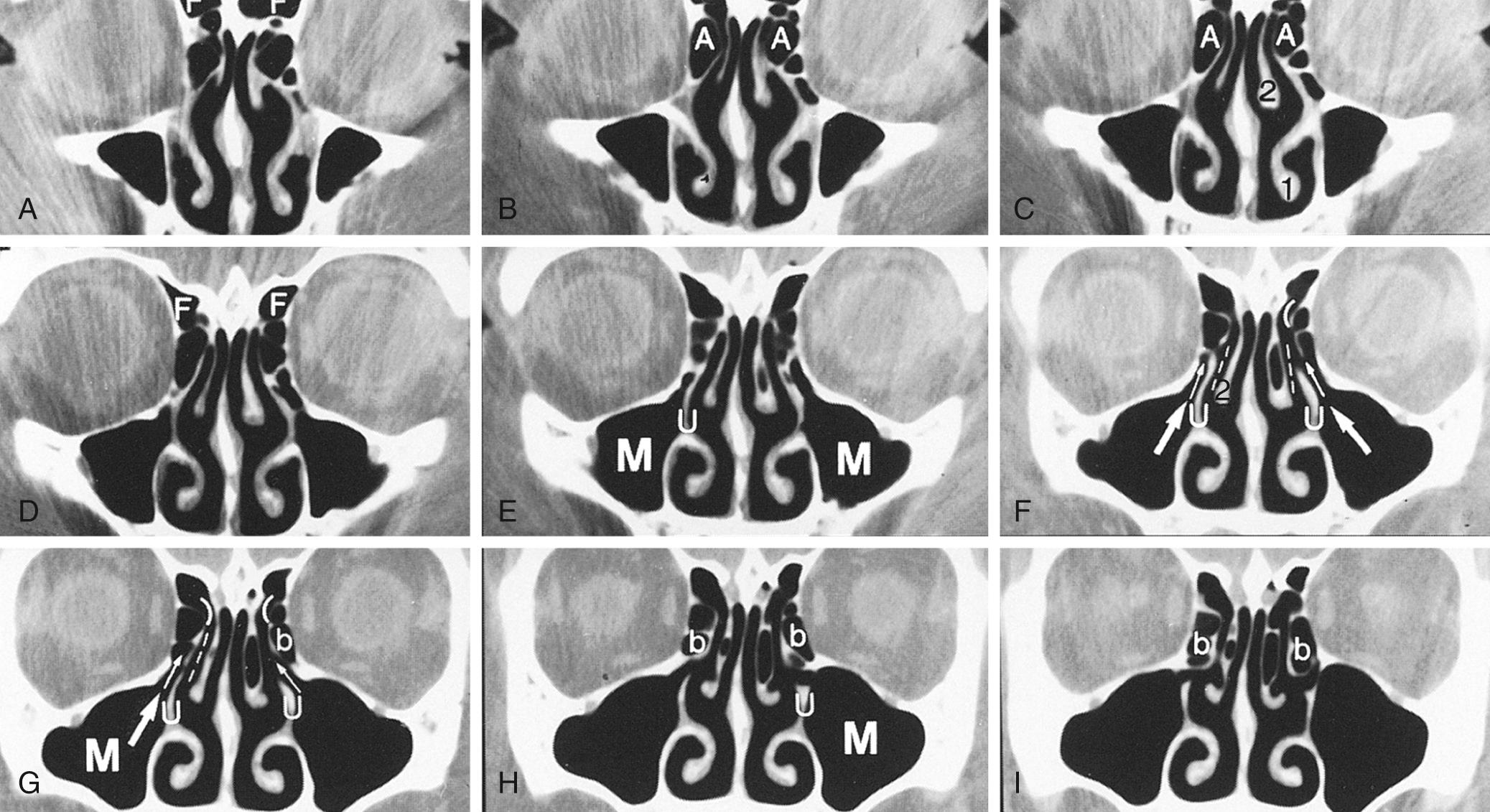
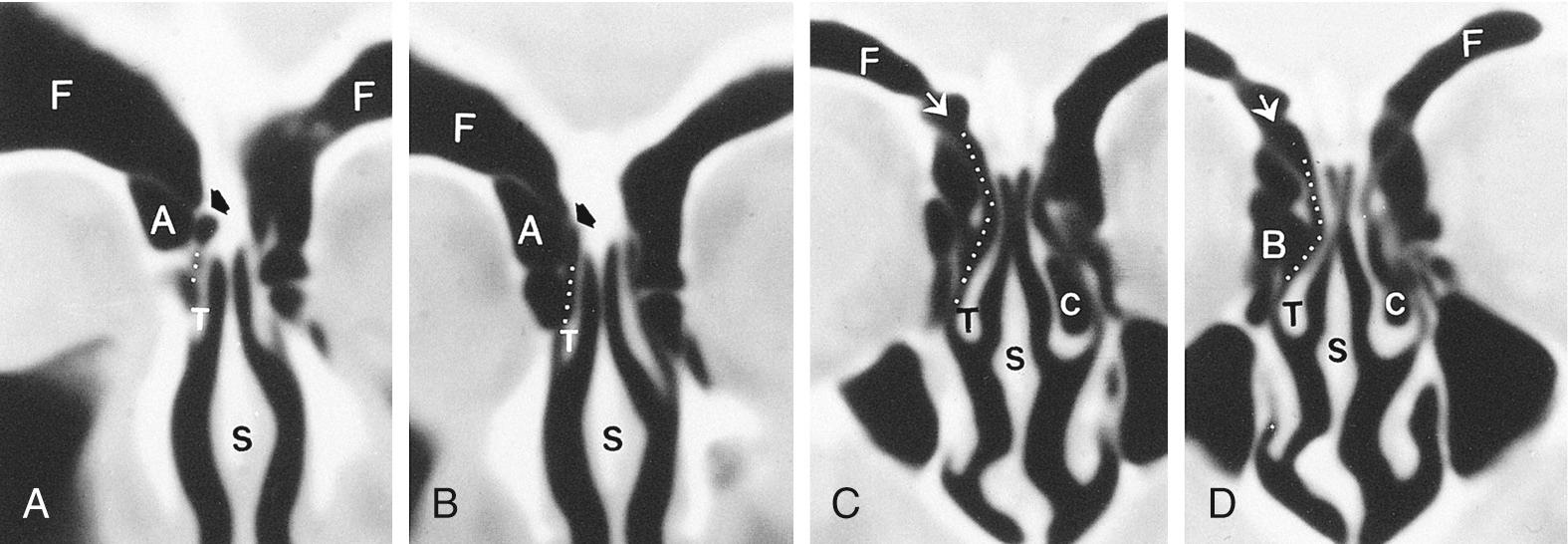
A number of laterally coursing bony septa that help form the ethmoid air cells attach to the middle turbinate at its posterior extent. The first of these bony leaflets is the basal or ground lamella of the middle turbinate, which laterally fuses with the lamina papyracea posterior to the ethmoid bulla. The basal lamella separates the anterior ethmoid cells from the posterior ethmoid cell. The posterior ethmoid sinus consists of air cells, which vary in number and shape among individuals; these air cells are situated between the basal lamella and the sphenoid sinus.
The sphenoid sinus, the most posterior sinus, is usually embedded in the clivus and is bordered posterosuperiorly by the sella turcica. It is often divided by a central septum coursing in the sagittal plane, although occasionally there can be more than one septum. Its ostium is located medially in the anterosuperior portion of the anterior sinus wall; this, in turn, communicates with the sphenoethmoidal recess, which lies just lateral to the nasal septum and is best seen in the sagittal and axial images, but can be seen sometimes on the coronal images also.
The number and position of the septa of the sphenoid sinus vary. Septa can adhere to the bony wall that covers the internal carotid artery, which occasionally impinges on the sphenoid sinus.
Anatomically, the paranasal sinuses are in close proximity to the anterior cranial fossa, cribriform plate, internal carotid arteries, cavernous sinuses, the orbits and their contents, and the optic nerves as they exit the orbits. Therefore extreme caution should be exercised when maneuvering instruments in the posterior-superior direction to avoid inadvertent penetration of these structures.
The paranasal sinuses and nasal mucosa are lined with abundant ciliated columnar cells that sweep the mucus stream from the sinuses toward three egresses: the frontal recess, the infundibulum–middle meatus, and the sphenoethmoidal recess. From there the mucus is propelled posteriorly through the nasal passage into the nasopharynx and is eventually swallowed.
An understanding of the physiology of the nasal cycle and the mucociliary clearance of the respective paranasal sinuses is a requisite for understanding the ostiomeatal channels, which provide intercommunication between the nasal cavity and the paranasal sinuses. The two main ostiomeatal channels are the anterior ostiomeatal unit —which includes the frontal sinus ostium, frontal recess, maxillary sinus ostium, infundibulum, and middle meatus—and the posterior ostiomeatal unit , which consists of the sphenoid sinus ostium, sphenoethmoidal recess, and the superior meatus. These channels provide communication between the ipsilateral frontal, anterior ethmoid, and maxillary sinuses. Any imaging of the paranasal sinuses should allow assessment of these ostiomeatal channels.
The side-to-side cyclic variation in the thickness of the nasal mucosa is known as the nasal cycle ( Fig. 38.3 ). The MRI signal intensity of the mucosal lining of the nasal cavity and the ethmoid sinuses varies with the nasal cycle. The anatomic evaluation should focus on the three egresses or “tight spots”: the frontal recess, the infundibulum, and the sphenoethmoidal recess.
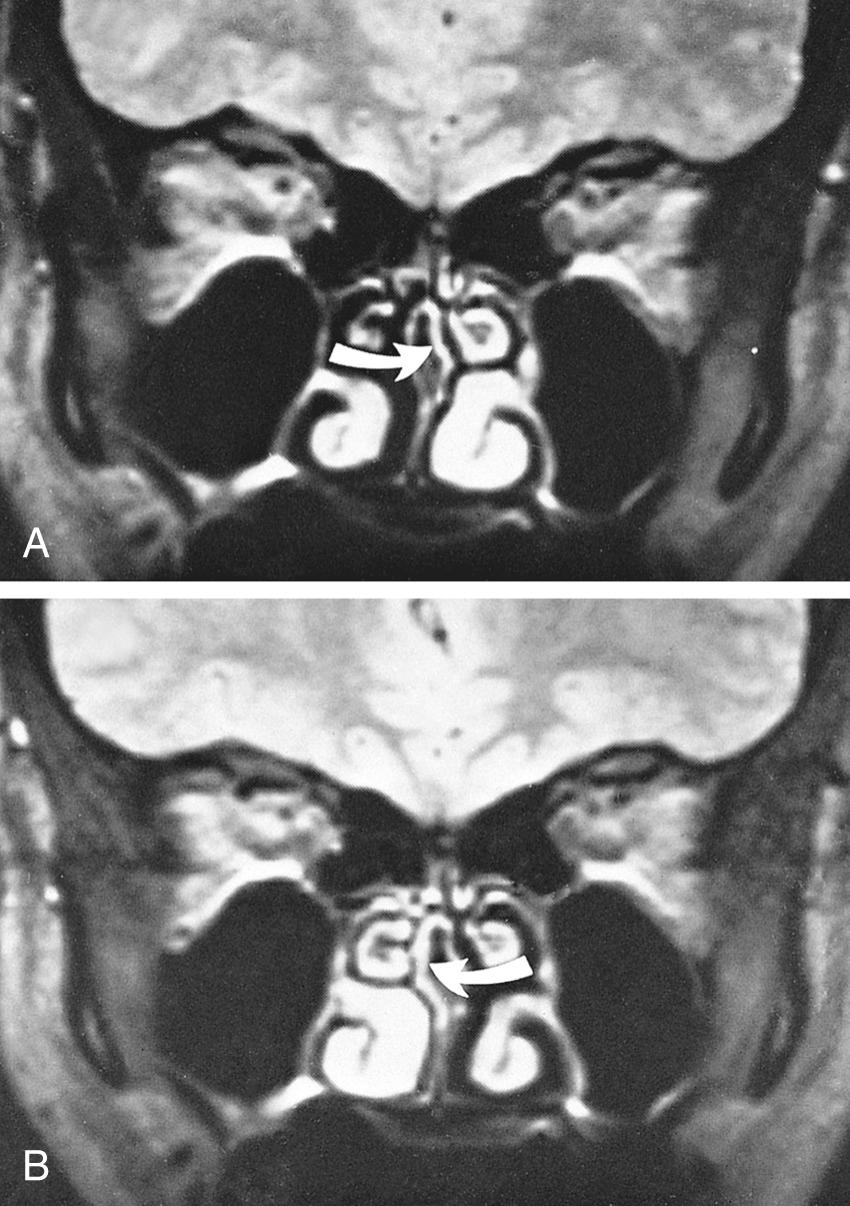
The frontal sinus drainage pathway is the most complex ( Fig. 38.4 ). The frontal sinus drains through an hourglass-shaped structure sometimes called the frontal sinus outflow tract (FSOT). The superior portion of this outflow tract is a funnel-shaped narrowing, called the infundibulum, at the inferior and medial aspect of the frontal sinus, which leads to the frontal ostium. The frontal ostium forms the waist of the hourglass in the most medial portion of the frontal sinus. The bottom portion of the hourglass is called the frontal recess, the narrowest portion of this outflow tract (the first “tight spot”), which, in turn, leads to the superior portion of the middle meatus, a drainage site shared with the anterior ethmoid sinus. Anterior to the frontal recess is the agger nasi cell, an ethmoturbinal remnant present in most individuals. It is aerated and represents the most anterior ethmoid air cell. It and frontal cells usually border the frontal recess. If the agger nasi is large, it may directly influence the patency of the frontal recess and the anterior middle meatus. The frontal recess is bordered posteriorly by the ethmoid bulla, usually the largest of the anterior ethmoid air cells, and inferiorly by the uncinate process. The anterior aspect of the uncinate process fuses with the posteromedial wall of the agger nasi cell and the posteromedial wall of the nasolacrimal duct. The free edge of the uncinate process delimits the inferior margin of the infundibulum ( Fig. 38.5 ), which is the air passage that connects the maxillary sinus ostium to the middle meatus, the second tight spot. The sphenoethmoidal recess, the third tight spot, receives drainage from the sphenoid sinus ( Fig. 38.6 ). It is situated just lateral to the nasal septum and leads to the posterior aspect of the superior meatus into which the posterior ethmoid cells drain.
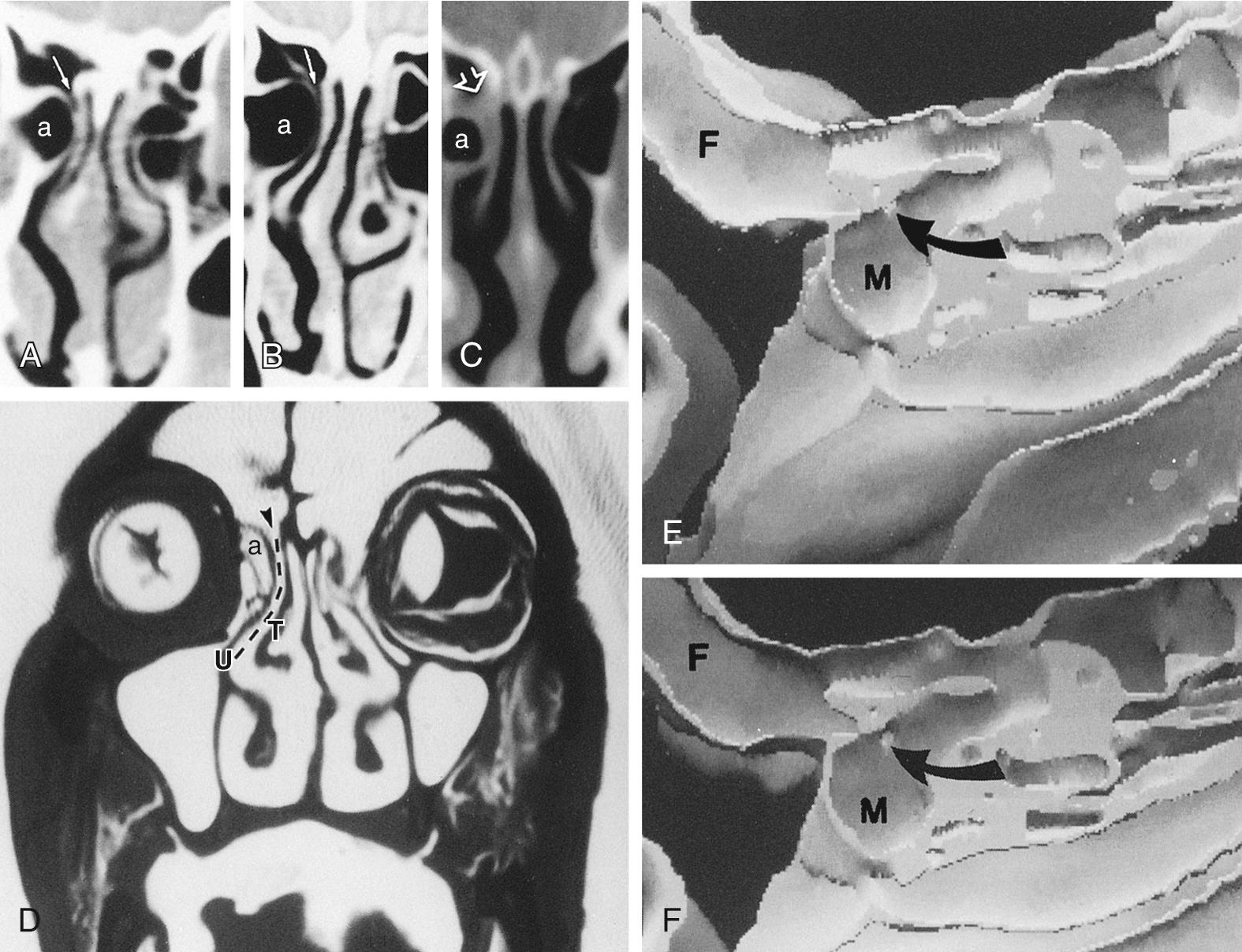
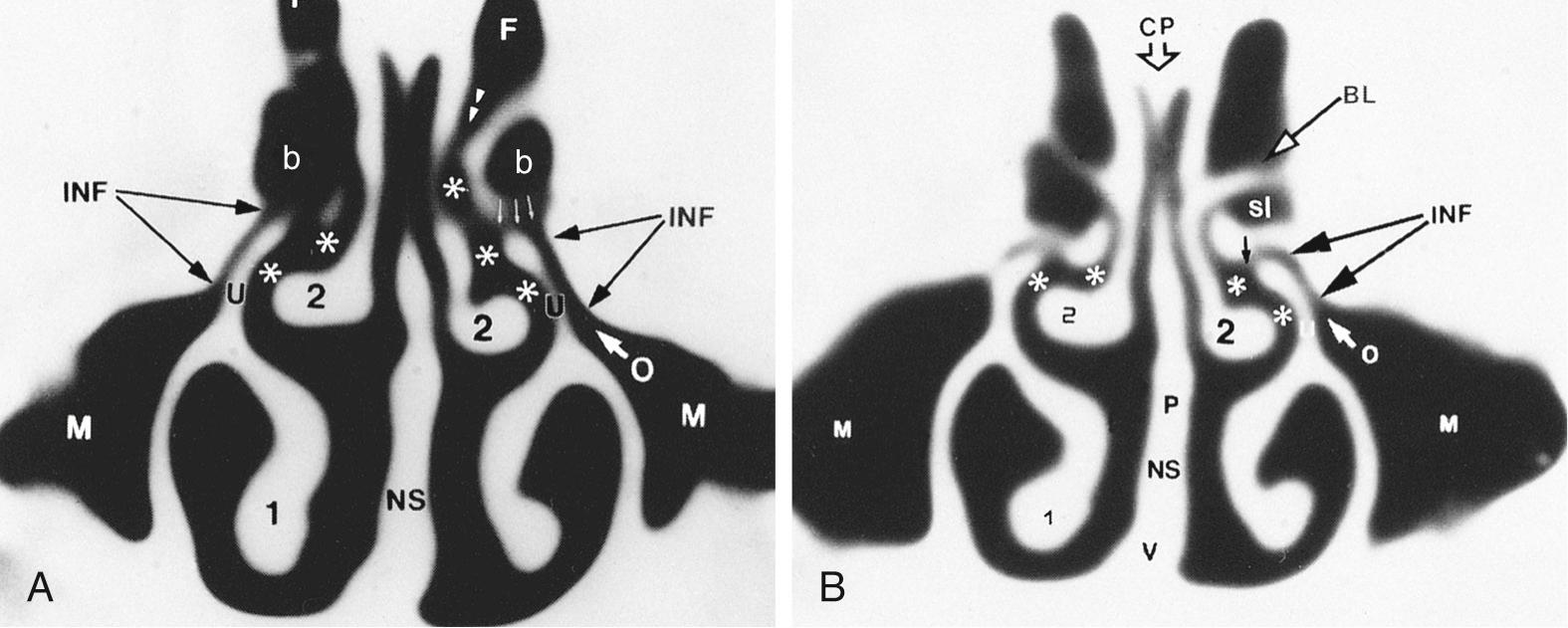
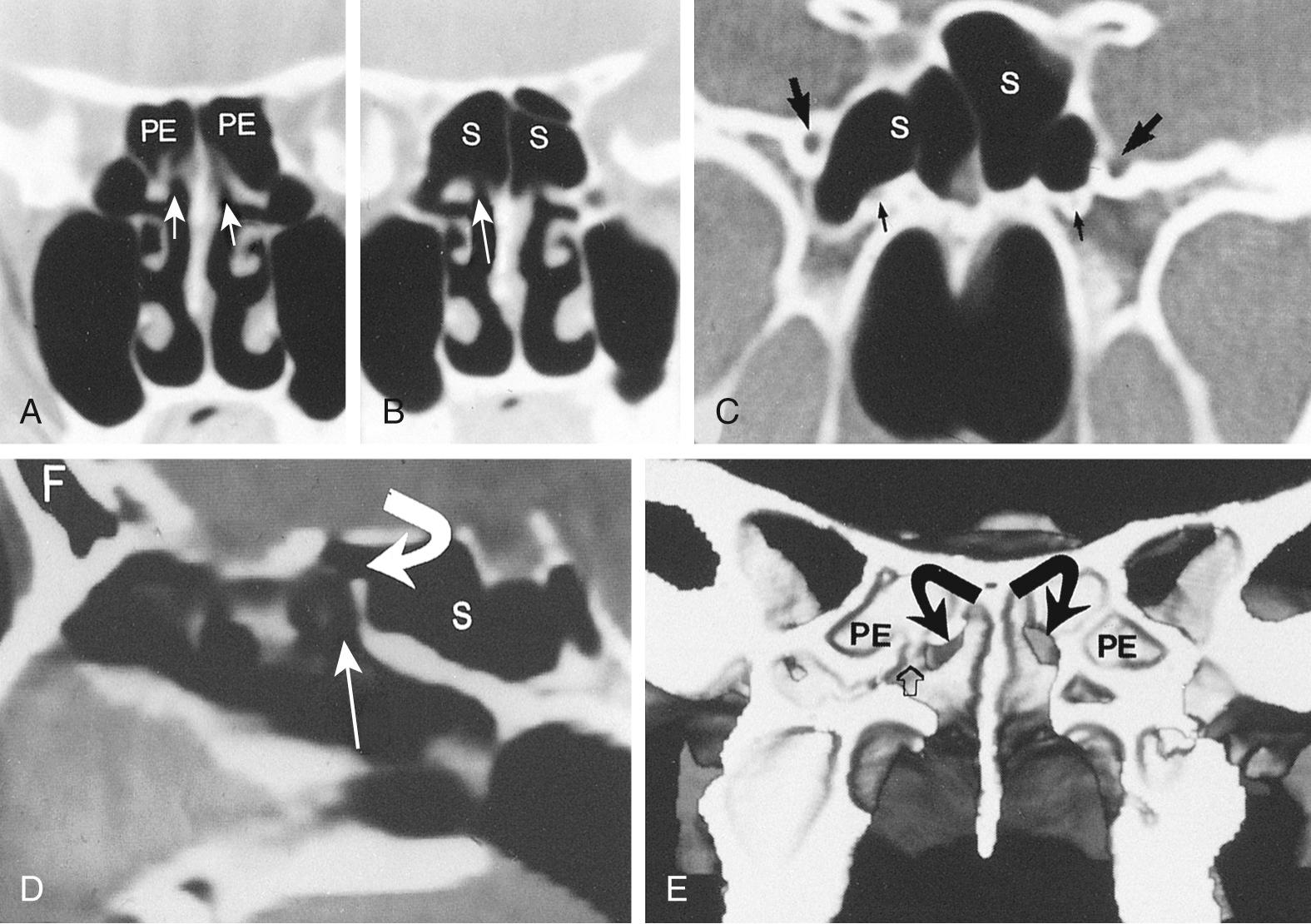
Posterior to the uncinate is the ethmoid bulla, usually the largest of the anterior ethmoid cells. The uncinate process usually courses medially and inferior to the ethmoid bulla, which is enclosed laterally by the lamina papyracea.
The gap between the ethmoid bulla and the free edge of the uncinate process defines the hiatus semilunaris. Medially, the hiatus semilunaris communicates with the middle meatus, the air space lateral to the middle turbinate. Laterally and inferiorly, the hiatus semilunaris communicates with the infundibulum, the air channel between the uncinate process and the inferomedial border of the orbit.
The middle turbinate is medial to the ethmoid bulla and the uncinate process. Anteriorly, it attaches to the medial wall of the agger nasi cell and to the superior edge of the uncinate process. Superiorly, the middle turbinate adheres to the cribriform plate. As it extends posteriorly, the middle turbinate emits the basal lamella, a laterally coursing bony structure that fuses with the lamina papyracea posterior to the ethmoid bulla.
In most individuals, the posterior wall of the ethmoid bulla is intact, and an airspace is usually found between the basal lamella and the ethmoid bulla. This airspace is called the retrobullar recess or suprabullar recess, depending on its extent, and it usually drains to the frontal recess ( Fig. 38.7 ). Dehiscence or total absence of the posterior wall of the ethmoid bulla is common and can provide communication between these two, usually separated, airspaces.
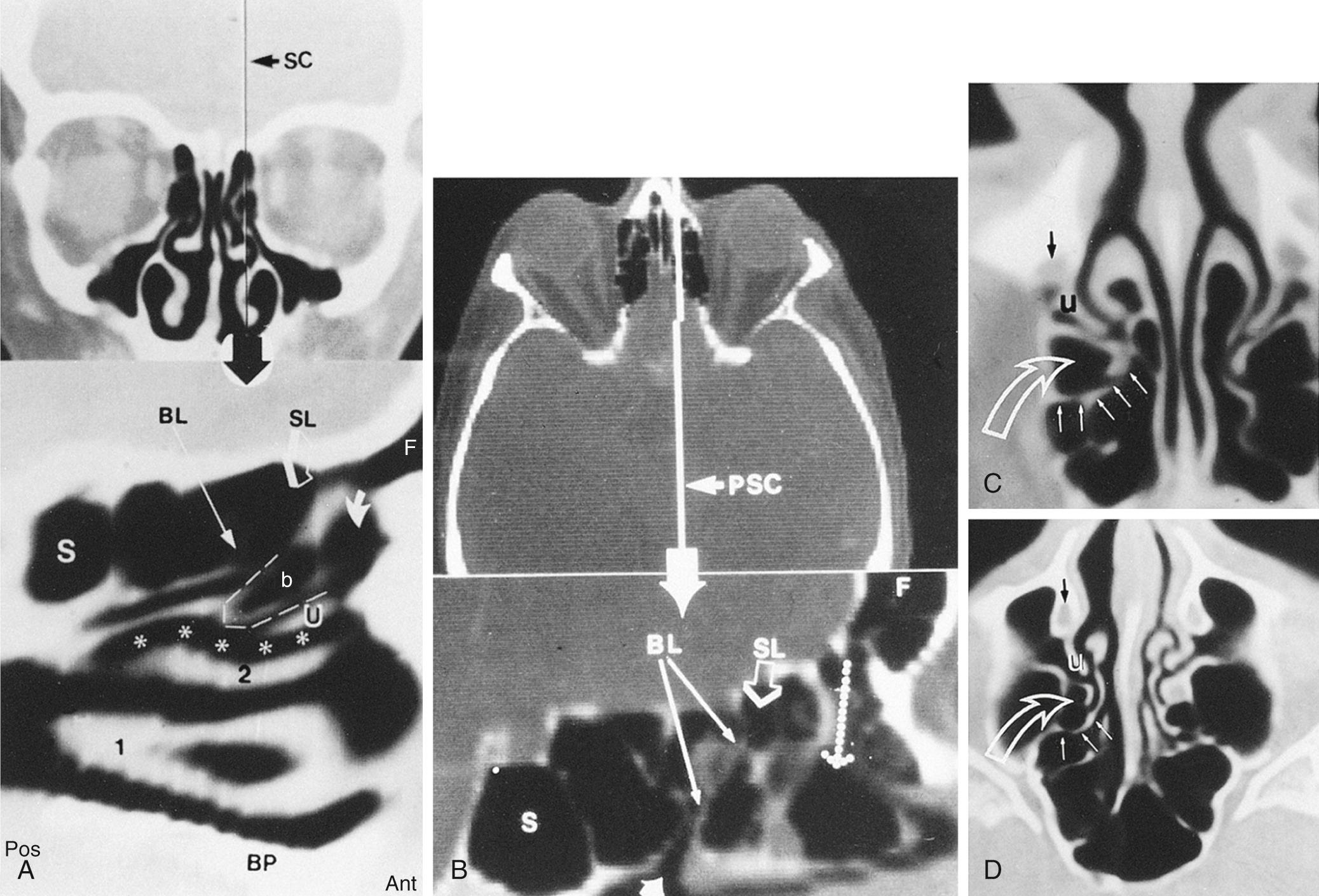
The cribriform plate of the ethmoid bone is that part of the anterior skull base through which the olfactory fibers pass from the olfactory cleft into the olfactory fossa. Anatomically, it is bordered anteriorly by the nasal and frontal bones, posteriorly by the anterior process of the sphenoid bone, medially by the nasal septum, and laterally by the superior and middle turbinates and the orbits. The lateral lamella of the cribriform plate is one of the thinnest parts of the skull base. The height of the lamella, and thereby the depth of the olfactory fossa, varies considerably and has been classified by Keros into three different types :
Keros 1: Lateral lamella is short with an almost flat olfactory fossa (1 to 3 mm) (30%)
Keros 2: Lateral lamella is longer, creating a moderately deep fossa (4 to 7 mm) (50%)
Keros 3: Lateral lamella is very long (8 to 16 mm) producing a very deep olfactory fossa (21%)
The olfactory fossa contains the olfactory bulb, which is intradural. Anatomically, it is bounded medially by crista galli, laterally by lateral lamella of cribriform plate, and inferiorly by the cribriform plate. The depth of the olfactory fossa can vary between the right and left sides (males > females).
Although the nasal anatomy varies significantly among patients, certain anatomic variations are relatively common. Some anatomic variations have an association with rhinosinusitis, although a causal relationship has not been established. These variations may contribute to mechanical obstruction of the ostiomeatal channels in these patients and may need to be addressed during surgery. In general, the relevance and significance of an anatomic variation are determined by their relationship with the ostiomeatal channels and nasal air passages. The highly variable nasal anatomy necessitates a careful presurgical assessment on an individual basis. The most common variations are discussed below.
Become a Clinical Tree membership for Full access and enjoy Unlimited articles
If you are a member. Log in here